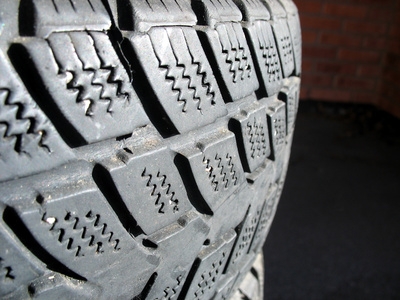
Blowouts are sudden, loud and unexpected, and when one happens, within seconds you can end up in a ditch or an accident. According to Michelin, there are approximately 523 fatalities and 23,000 accidents per year due to tire blowouts. Several common causes of blowouts exist, and the best way to protect yourself is to minimize your chances of having one. Watch the wear on your tires, keep them inflated at the proper pressure and check for damage if you hit a pothole or rock. Avoid curbs and check your tires for slow leaks.
If a tire is underinflated, excessive flexing takes place in the sidewalls, causing them to become hot. This can lead to a blowout or tread separation, especially during summer if the vehicle is driven at a high speed on paved roads. If you inflate your tires until "they look right," chances are they're overinflated. Use a tire gauge and check the tire inflation decal on the door jamb for correct pressure. Too much air in a tire increases the roughness of the ride and vulnerability to damage if potholes or curbs are hit.

Overloading is often an issue with pickup trucks, SUVs and vans whose heavy loads exceed tire capability. Driving an overloaded vehicle is asking for trouble. Check the load rating coded on the side of the tire and upgrade to tires with a higher rating to avoid blowouts.

Most motorists try to avoid debris, rocks, nails, lumber and potholes, but sometimes this is impossible. The result can be a sudden blowout, a slow leak or damage that becomes worse, ending in a blowout. Low profile tires are vulnerable to sidewall damage from hitting curbs or potholes due to the narrow distance between the tread and the rim.

Non-speed rated tires driven at sustained high speeds are more likely to blow out. If it's hot or tires are badly worn, chances of a blowout are greater. Speed rated tires have additional reinforcements and can dissipate heat better than ordinary tires.

Poor adhesion between tread and belts occurs during tire manufacture, resulting in tread separation and blowouts. Inspect your tires carefully, watching for bulges, missing pieces of rubber and cracks. Poor puncture repair allows moisture to penetrate the tread, reaching the steel belts and causing rust, leading to tread separation. If tires have been mounted on an incorrectly sized rim or damaged during mounting process, a leaking tear results.

When tread is worn down so the wear bars are even with surrounding tread, the tire should be replaced. If white cords can be seen, the tire is unsafe and likely to blow out. Experts recommend replacement of tires that are six years old, even if they show little wear, due to their increased risk of blowout. Older rubber becomes harder and more brittle and loses elasticity, while the reinforcing cords inside the tire weaken and deteriorate. Danger increases when the vehicle is overloaded or driven at high speeds.
